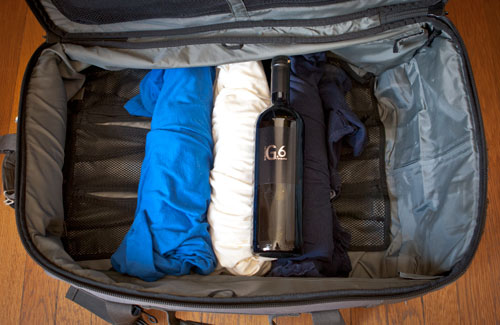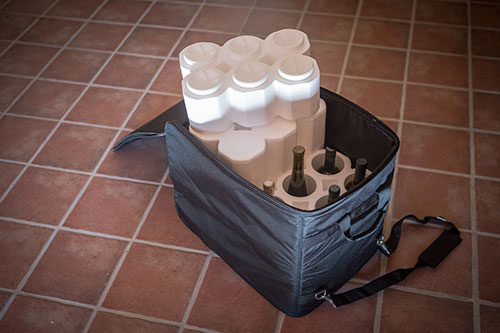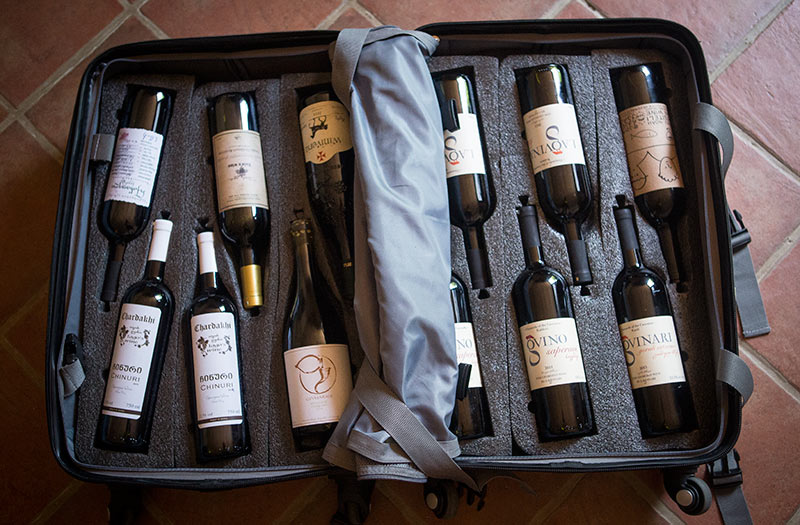Being in the midst of the summer holidays and given our focus on wine travels, we thought it appropriate to address the age-old need of the “entourist”: bringing your wine back home. We’ve found that there are a great many urban legends dominating this discussion. So here are a few of the tips we’ve learned over the years when it comes to bringing back that special bottle(s). Before we dig in, let’s toss up a couple of disclaimers:
1) Regulations as to how much wine you can bring in to a country are all over the map and we don’t know what they are for where you live. In other words, look in to it before whatever you bring back either gets confiscated or gets you tossed in jail (now most countries have customs information online, otherwise give them a call).
2) We’ve had no problems to date with the packing system we use. This does not mean it’s 100% foolproof. Wine can always break in your suitcase and you are always taking a chance, so please, please keep this in mind when packing it in that it still could break and bathe your belongings in grape–that probably won’t come out.
Planning for the return
Before you even leave, think about if you’re going to be bringing back some bottles. Plan on each 750ml bottle weighing about 1.5kg. With a 23kg maximum amount for a checked suitcase that means at most you could bring back 15 bottles of wine. That seems fantastic until you realize you need to pad them somehow and (unless you’ve opted to bring a second suitcase or are planning to spend your vacation naked) you’re going to need somewhere to store your clothes and other traveling items. For a lean packer on a 10 day trip, you can probably fit about six bottles. For those who pack more, you might just be looking at three.
It’s a mighty good idea to weigh your bag at home prior to leaving to see just how much you can bring back as re-sorting your bag at the check-in line for your return flight is extremely messy and sometimes embarrassing.
How much can I bring back?
This is where everything goes to hell because we’ve never been able to ascertain with absolute certainty just how many bottles of wine you can bring back in to a country legally. At the moment, we’re residing in the United States, so we’ll base things on their model, which doesn’t clear things up that much. Official policies don’t really help as they’re geared towards hard alcohol (more than 24% alcohol and five liters at most), not wine. You should note that all wine bottles will need to be in checked luggage, though, as the days of bringing them as carry-on are long gone.
As general rule of thumb (and keep in mind we have no legal authority in this matter) what we’ve heard is that whatever you can pack and bring back is fine as long as you declare it and say that it was a gift. The agents should charge an import tax in much the same way as other ‘luxury’ items you might have purchased, but they usually don’t bother when it’s below a case as the tax collected would be quite low. The only time we’ve ever been hassled was when we were bringing in a case and a half of Spanish wine after the holidays and didn’t declare it. Given the time of year we were returning, the border agent kept berating us and we admitted to having a couple of bottles which got us a “tsk, tsk, declare it next time”.
Wine is not subjected to the raw food ban (don’t even think of bringing back unpasteurized cheeses, jamón, prosciutto, or a lot of other fun things) so it’s really just the dollar amount that’s the issue from what we’ve heard, if the value of the wines is over a large amount (maybe $1,000) then you might have to pay an import tax as the authorities might think that it’s not for personal consumption. Of course we’ve heard of others bringing back in very expensive bottles, stating that they’re in the wine business and what they had were merely “samples”. Despite the fuzziness of all of this, that is probably asking for trouble as the US can be very difficult in these matters.
Packing
So, say you’ve picked up a couple of bottles and now want to pack them so that they won’t break. We’ve found that the best way to do this is as shown here:

Obviously, you’ll have other items in your suitcase and that one bottle of tasty Bibich G6 Grenache should be wrapped as well, but we wanted to show the bottle placement properly. Given that baggage handlers beat the living hell out your luggage, a glass bottle in a suitcase seems like it would always be in danger of breaking. But we’ve found that placing the bottle across the suitcase, wrapped in dirty clothes or towels (preferable older ones that you don’t care about in case something actually does break), placed around the middle of the suitcase with a good deal of clothing between them and the bottom and the sides, has worked exceedingly well to date. The suitcases we travel with are the softer type from Decathlon (a French brand), not those rigid “secret agent” shell cases some people swear by.
If you want to make sure they shift even less during the baggage handling “process” then put the suitcase on one end, shake it up and down a little, unzip the top (if you can) and you’ll see a bit of space up there. Typically, we use this to stuff some random forgotten item, but in this case, pack it with whatever else you might have to go in there and then zip it up. It will make the whole suitcase even more solidly packed.
We’ve hauled back wine on flights from London, Barcelona, and Paris to San Francisco without any problem. We’ve also brought wines on routes from Cape Town – Johannesburg – Nairobi – Abidjan (that had 10 bottles in one suitcase) as well as an insane Santiago – Atlanta – San Francisco – Paris – Abidjan all without breaking. You might say that we’ve just been lucky and we probably have, but this has worked well to date. For those who don’t like the idea of wrapping their clothes around a bottle that could break, we came across the Bottle Bully which is an inflatable, reusable (we like that!) air cushion to wrap around wine to take it in your luggage–or just for general shipping.
But we’re of the opinion that this packing method has worked because the only time we actually had a bottle break was on a flight from Croatia to California where the bottle was placed longwise in the suitcase. That’s a big no-no as it exposes the bottle’s most breakable axis to the luggage handlers. After all, wineries store huge piles of wine the same way we do in our suitcases and as long as the glass doesn’t clink against another hard surface, the possibility of breakage is quite small.
Conclusion
So there you have it, traveling with wine is not difficult and in fact quite fun once you’re sitting at home remembering your travels. We’d love to hear your thoughts as this is always a work in progress from the last decade of our travels and we’re definitely open to even more improved ideas.



We’ve had luck using the same method of cross-wise packing, wrapping each bottle in bubble wrap (which we carry with us, knowing we will need it — but it can be found locally if you have time to look for it) & pieces of styrofoam around the outside perimeter. We use the harder-side, light weight suitcases. We did have a bottle of olive oil break, but it was packed (WELL packed with bubble wrap & cardboard, but it was in a small, soft-sided, insulated bag — the rest of the bottles of olive oil made it, but that broken one created a mess!